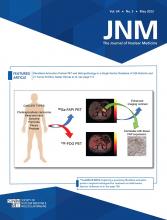Visual Abstract
Abstract
18F-PSMA-1007 PET is used in the management of patients with prostate cancer. However, recent reports indicate a high rate of unspecific bone uptake (UBU) with 18F-PSMA-1007, which may lead to a false-positive diagnosis. UBU has not been evaluated thoroughly. Here, we evaluate the frequency of UBU and bone metastases separately for 18F-PSMA-1007 and 68Ga-PSMA-11 in biochemical recurrence (interindividual comparison). Additionally, we investigate UBU seen in 18F-PSMA-1007 through follow-up examinations (intraindividual comparison) using 68Ga-PSMA-11 PET, bone scintigraphy, and MRI. Methods: First, all patients (n = 383) who underwent 68Ga-PSMA-11 PET between January 2020 and December 2020 and all patients (n = 409) who underwent 18F-PSMA-1007 PET between January 2020 and November 2021 due to biochemical recurrence were included for an interindividual comparison of bone metastases and UBU rate. In a second approach, we regarded all patients with UBU in 18F-PSMA-1007, characterized by focal bone uptake with an SUVmax > 4 and prostate-specific antigen (PSA) ≤ 5 ng/mL, who underwent additional 68Ga-PSMA-11 PET (n = 17) (interindividual comparison). Of these, 12 patients also had bone scintigraphy and whole-body MRI within a 1- to 5-wk interval. Bone uptake seen on 18F-PSMA-1007 but not on any of the other 4 modalities (CT, MRI [n = 1], bone scanning, and 68Ga-PSMA-11 PET) was recorded as false-positive. Results: Patients scanned with 18F-PSMA-1007 PET had a significantly higher rate of UBU than those scanned with 68Ga-PSMA-11 (140 vs. 64; P < 0.001); however, the rate of bone metastases was not significantly different (72 vs. 64; P = 0.7). In the intraindividual comparison group, workup by CT, MRI, bone scanning, and 68Ga-PSMA-11 PET resulted in a positive predictive value for 18F-PSMA-1007 focal bone uptake (mean SUVmax, 6.1 ± 2.9) per patient and per lesion of 8.3% and 3.6%, respectively. Conclusion: In patients with PSA ≤ 5 ng/mL and SUV > 4 at biochemical recurrence, most 18F-PSMA-1007 focal bone uptake is likely to be false-positive and therefore due to UBU. In the case of low clinical likelihood of metastatic disease, 18F-PSMA-1007 bone uptake without morphologic surrogate should be assessed carefully with regard to localization and clinical context. However, the rate of bone metastases was not higher with 18F-PSMA-1007 in the clinical routine, indicating that experienced reporting physicians adjust for UBU findings.
Footnotes
Published online Dec. 2, 2022.
- © 2023 by the Society of Nuclear Medicine and Molecular Imaging.








